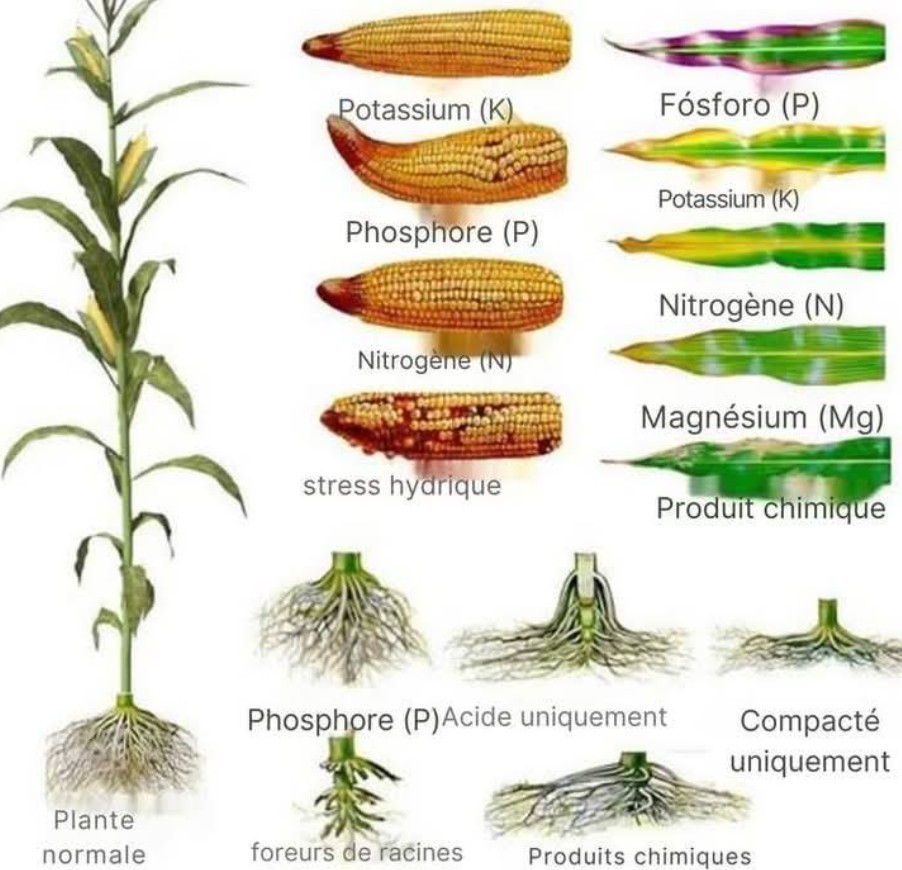The Impact of Nutritional Deficiencies and Adverse Conditions on Corn Cultivation
Corn, a staple crop for many regions around the world, is highly sensitive to soil nutrients and environmental conditions. Nutrient deficiencies and adverse conditions can have a significant impact on the growth and yield of corn plants. Understanding how these factors affect corn is key to maintaining healthy crops and maximizing production. In this article, we will explore the effects of nutritional deficiencies and adverse conditions on corn cultivation and how to manage them effectively.
1. Nitrogen Deficiency
Symptoms: Nitrogen is one of the most important nutrients for corn, and a lack of it can be seen in the yellowing of the lower leaves, which gradually spreads upward. Plants may also exhibit stunted growth, reduced stalk strength, and poor kernel development.
Impact on Growth: Nitrogen deficiency affects the plant’s ability to produce chlorophyll, the substance that helps plants photosynthesize. This leads to poor photosynthesis, reducing the plant’s overall energy, growth, and productivity.
Management: Applying nitrogen-rich fertilizers, such as ammonium nitrate or urea, can help restore nitrogen levels. Additionally, proper crop rotation and the use of nitrogen-fixing cover crops can help replenish nitrogen in the soil.
2. Phosphorus Deficiency
Symptoms: Phosphorus deficiency in corn plants often results in purpling of the leaves, especially in young plants. In severe cases, the plant may show delayed growth and poor root development.
Impact on Growth: Phosphorus is crucial for root development and energy transfer within the plant. Without adequate phosphorus, corn plants are unable to develop strong roots, which reduces the plant’s ability to absorb water and other essential nutrients.
Management: Fertilizers that contain phosphorus, such as superphosphate, can be applied to the soil. Early soil testing can also help prevent phosphorus deficiency before it affects growth.
3. Potassium Deficiency
Symptoms: The first signs of potassium deficiency in corn plants are typically yellowing at the leaf edges, followed by browning and curling. Weak stalks and smaller ears are also common indicators.
Impact on Growth: Potassium is vital for regulating water, enzyme activation, and photosynthesis in plants. Without enough potassium, corn plants suffer from weak cell walls, poor water retention, and an increased risk of disease.
Management: Potassium-based fertilizers, such as potassium chloride, can be applied to the soil to restore potassium levels. Proper irrigation practices also help maintain the balance of potassium in the soil.
4. Calcium Deficiency
Symptoms: Calcium deficiency often leads to leaf curling, especially in the growing tips. The plant may also show stunted growth and deformed kernels.
Impact on Growth: Calcium is essential for cell wall structure and the regulation of nutrients in the plant. A lack of calcium leads to weakened cell structure, affecting growth and fruit development.
Management: Applying lime to raise soil pH or using calcium nitrate or calcium chloride can help correct calcium deficiencies. Maintaining proper soil pH is crucial for calcium uptake.
5. Magnesium Deficiency
Symptoms: Magnesium deficiency in corn plants can be recognized by interveinal chlorosis, where the areas between the veins of the leaves turn yellow, while the veins themselves remain green.
Impact on Growth: Magnesium is an essential component of chlorophyll and is crucial for photosynthesis. Without adequate magnesium, the plant’s ability to produce energy through photosynthesis is compromised, leading to poor growth and reduced yield.
Management: Applying magnesium sulfate (Epsom salt) to the soil can help alleviate magnesium deficiency. Soil tests will help determine if magnesium levels are low and need supplementation.
6. Water Stress
Symptoms: Water stress in corn can result from both overwatering and underwatering. Symptoms include wilting, curling leaves, stunted growth, and poor kernel development.
Impact on Growth: Corn is highly sensitive to water stress, and both excess and insufficient water can lead to poor growth. Water stress disrupts nutrient uptake, weakens the plant’s structure, and reduces the yield of the crop.
Management: Consistent irrigation is essential for maintaining healthy corn plants. Use drip irrigation or sprinklers to provide a steady water supply. Soil drainage and the use of moisture-retaining organic mulches can also help prevent water stress.
7. Pest Infestation
Symptoms: Pests such as aphids, corn borers, and rootworms can damage corn plants by feeding on the leaves, stalks, and roots. This leads to visible holes, brown spots, and weakened plants. Insects may also spread diseases, further harming the plant.
Impact on Growth: Pests can severely damage corn by weakening the plant, reducing photosynthesis, and causing direct damage to the ears and stalks. Infestations often lead to lower yields and increased susceptibility to disease.
Management: Regular pest monitoring is crucial. Natural predators, like ladybugs, or the use of organic insecticides such as neem oil can help control pests. Additionally, crop rotation and removing infected plant debris can help prevent infestations in the next planting season.
Conclusion
Nutritional deficiencies and adverse conditions significantly affect the growth and yield of corn crops. By understanding the symptoms and impacts of deficiencies in nitrogen, phosphorus, potassium, calcium, and magnesium, as well as managing water stress and pest infestations, you can take proactive steps to maintain healthy plants and maximize your harvest. Regular soil testing, proper fertilization, irrigation, and pest management practices are key to ensuring successful corn cultivation.
By addressing these factors and providing the right care, you can improve the health and productivity of your corn plants, leading to a bountiful harvest.
